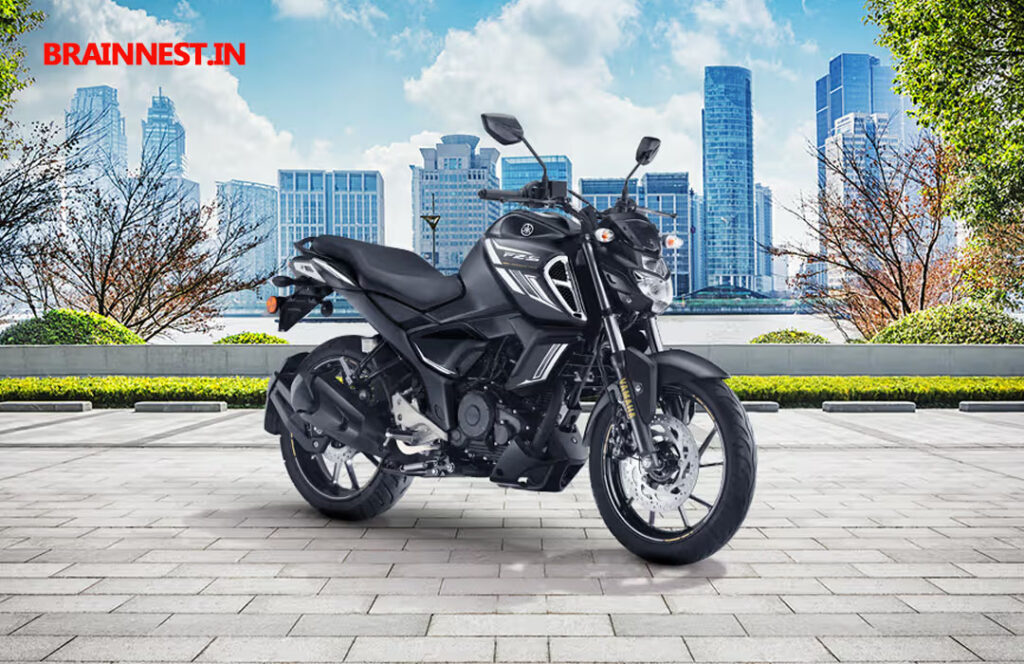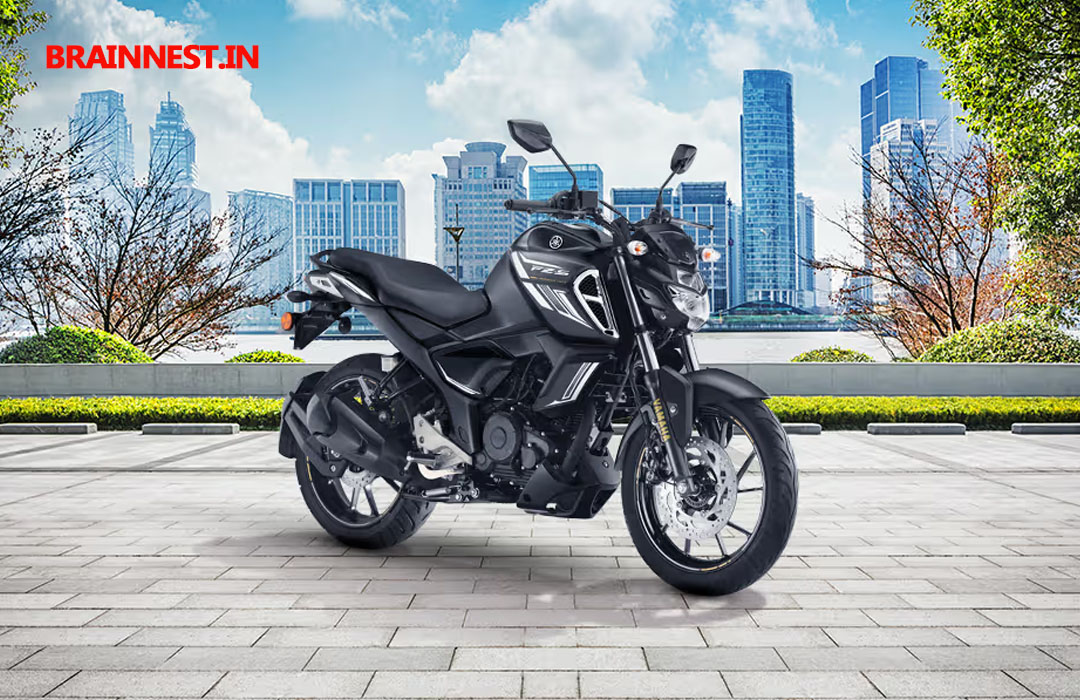Are you looking for a motorcycle that combines bold aesthetics, reliable performance, and everyday practicality to conquer India’s bustling city streets and open roads? The Yamaha FZS-Fi 2025 is the ultimate stylish street companion, offering a muscular design, refined engine, and modern features at an affordable price. Competing with the TVS Apache RTR 160 4V, Bajaj Pulsar N160, and Hero Xtreme 160R 4V, it’s a favorite among young riders and commuters. In this comprehensive Yamaha FZS-Fi 2025 review from BrainNest.in, we dive into its design, performance, technology, pricing, and more to help you decide if it’s your ideal ride. Let’s explore why the FZS-Fi shines in 2025!
Why the Yamaha FZS-Fi 2025 Stands Out
The Yamaha FZS-Fi 2025 builds on the iconic FZ series, which redefined India’s 150cc segment since its 2008 debut. Priced between ₹1.34 lakh and ₹1.45 lakh (ex-showroom), it offers multiple variants, including the FZS-Fi Hybrid with mild-hybrid technology. Powered by a BS6 Phase 2B-compliant 149cc engine, it delivers 12.4 PS, single-channel ABS, and an impressive 60 kmpl mileage (ARAI) in its hybrid variant. With 12,979 units sold in May 2025, the FZ series remains a market leader. Its blend of style, efficiency, and urban agility makes it a top stylish street companion.
At BrainNest.in, we provide expert automotive insights to guide your purchase decisions. Visit our About Us page or reach out via Contact Us for personalized advice. Here’s why the FZS-Fi 2025 excels in the 150cc segment.
Design and Styling: Bold and Muscular
Exterior: Streetfighter Swagger

The Yamaha FZS-Fi 2025 embodies a rugged streetfighter aesthetic with a chiseled 13-liter fuel tank, aggressive tank shrouds, and a sleek LED headlamp with DRLs. The 2025 update introduces vibrant colors like Ice Fluo-Vermillion, Cyan Metallic Grey, Racing Blue, and Matte Black, paired with refreshed graphics. Tank-integrated turn indicators and a sculpted side panel on the FZS-Fi Hybrid enhance its premium look. Measuring 2,073 mm long, 770 mm wide, and 1,030 mm tall with a 1,330 mm wheelbase, it’s compact yet bold. The 165-mm ground clearance and 140/60-17 rear tire ensure stability.
While its design is iconic, it feels slightly dated compared to the sharper TVS Apache RTR 160 4V, but the premium build quality cements its status as a stylish street companion.
Interior: Ergonomic and Rider-Friendly
The FZS-Fi’s rider interface prioritizes comfort and functionality. The FZS-Fi Hybrid features a full-color TFT display with Bluetooth-enabled Y-Connect for navigation, call/SMS alerts, and maintenance tracking. The standard FZS-Fi uses a digital LCD cluster displaying speed, fuel, trip data, and an ECO indicator. The 790-mm seat height suits riders of varying heights, and the upright handlebar with neutral footpegs offers a relaxed yet sporty posture. The firm seat supports short rides but may cause discomfort on journeys exceeding two hours, fitting its role as a stylish street companion.
Performance: Smooth and Efficient
Engine and Powertrain
The Yamaha FZS-Fi 2025 is powered by a 149cc, air-cooled, fuel-injected, single-cylinder engine with Yamaha’s Blue Core technology, producing 12.4 PS at 7,250 rpm and 13.3 Nm at 5,500 rpm. Paired with a five-speed gearbox, it delivers smooth low-end torque, ideal for city traffic, though it lacks punch above 7,000 rpm, with a top speed of 115 km/h. The FZS-Fi Hybrid’s Smart Motor Generator (SMG) assists at low RPMs, boosting efficiency to 60 kmpl (ARAI), compared to 49.31 kmpl for standard variants. Real-world mileage ranges from 45-55 kmpl, making it a frugal stylish street companion.
Compared to the Bajaj Pulsar N160’s 16 PS, the FZS-Fi prioritizes refinement over raw power, suiting urban commuters.
Handling and Ride Quality
The FZS-Fi’s delta-box frame, telescopic front forks with fork boots, and preload-adjustable rear monoshock ensure agile handling. At 137 kg, it’s light and nimble in city traffic, though the wide handlebar can feel cumbersome in tight spaces. The 282-mm front disc with single-channel ABS and 220-mm rear disc (standard on Deluxe/Hybrid) provide strong braking, but dual-channel ABS is limited to the V4 Deluxe. The sporty suspension handles corners well but feels stiff on potholed roads, impacting long-ride comfort. Its agility and balance make it a true stylish street companion.
Technology and Features: Modern Yet Practical
Infotainment and Connectivity
The FZS-Fi Hybrid’s TFT display with Y-Connect Bluetooth is a standout, offering turn-by-turn navigation, smartphone alerts, and fuel consumption tracking. The standard FZS-Fi’s LCD cluster is functional but lacks connectivity, displaying speed, odometer, and fuel data. LED headlights, dynamic turn indicators (Hybrid/Deluxe), and E20 fuel compatibility are standard, though halogen indicators on lower variants feel outdated. The hybrid system’s start/stop feature enhances city efficiency, but its impact is subtle. Compared to the TVS Apache’s advanced tech suite, the FZS-Fi balances simplicity and modernity, fitting its stylish street companion role.
Safety Features
Safety features include:
- Single-channel ABS (dual-channel on V4 Deluxe)
- 100/80-17 front and 140/60-17 rear tubeless tires for grip
- Traction control (V4 Deluxe and Hybrid)
- Side-stand engine cut-off switch
- Fork boots for dust protection
The absence of dual-channel ABS on lower variants and a rear drum brake on the base model are drawbacks compared to the Hero Xtreme 160R 4V’s standard dual-channel ABS. The lightweight chassis and low seat height boost confidence, making the FZS-Fi a safe stylish street companion.
Pricing and Variants: Budget-Friendly Options
The Yamaha FZS-Fi 2025 is available in four variants in India:
| Variant | Ex-Showroom Price (₹) | Key Features |
|---|---|---|
| FZS-Fi V3 STD | ₹1,34,900 | LCD cluster, LED headlamp, single-channel ABS, Matte Red/Matte Grey |
| FZS-Fi V3 Deluxe | ₹1,35,381 | Rear disc brake, premium colors, Matte Black/Metallic Grey |
| FZS-Fi V4 Deluxe | ₹1,36,381 | Dual-channel ABS, traction control, dynamic indicators, Ice Fluo-Vermillion |
| FZS-Fi Hybrid | ₹1,44,800 | TFT display, Y-Connect Bluetooth, hybrid tech, Cyan Metallic Grey/Racing Blue |
On-road prices in Delhi range from ₹1.53 lakh to ₹1.64 lakh. The FZS-Fi is competitively priced against the TVS Apache RTR 160 4V (₹1.47 lakh) and Bajaj Pulsar N160 (₹1.33 lakh), offering strong value for a stylish street companion. EMI starts at ₹4,424 for the Hybrid variant.
What’s New in 2025?
The 2025 FZS-Fi introduces key updates:
- Mild-Hybrid Technology: FZS-Fi Hybrid features a Smart Motor Generator for improved efficiency (60 kmpl ARAI).
- TFT Display: Hybrid variant gets a Bluetooth-enabled TFT screen with navigation.
- New Colors: Ice Fluo-Vermillion, Cyan Metallic Grey, Racing Blue, and Matte Black refresh the lineup.
- Traction Control: Standard on V4 Deluxe and Hybrid, enhancing safety.
- E20 Fuel Compatibility: All variants support cleaner E20 fuel.
These updates keep the FZS-Fi competitive, though a rear disc brake across all variants and a design overhaul would elevate its stylish street companion appeal.
Pros and Cons of the 2025 Yamaha FZS-Fi
Pros
- Bold, muscular design with premium color options
- Efficient 149cc engine with up to 60 kmpl mileage
- Lightweight (137 kg) for agile urban handling
- Affordable pricing starting at ₹1.34 lakh
- Comfortable ergonomics for a stylish street companion
Cons
- Design feels dated compared to newer rivals
- No dual-channel ABS on lower variants
- Firm suspension impacts long-ride comfort
- Limited high-speed performance
Comparison with Competitors
| Feature | Yamaha FZS-Fi 2025 | TVS Apache RTR 160 4V | Bajaj Pulsar N160 |
|---|---|---|---|
| Starting Price (₹) | ₹1,34,900 | ₹1,47,350 | ₹1,33,173 |
| Engine | 149cc, 12.4 PS | 159.7cc, 17.55 PS | 160.3cc, 16 PS |
| Mileage (kmpl) | 49.31-60 (ARAI) | 41.4 (ARAI) | 45 (ARAI) |
| Weight (kg) | 137 | 144 | 154 |
| Seat Height (mm) | 790 | 800 | 795 |
| Ground Clearance (mm) | 165 | 180 | 165 |
The FZS-Fi offers superior mileage and affordability, but the Apache RTR 160 4V provides more power and dual-channel ABS. The Pulsar N160 balances performance and features but is heavier, making the FZS-Fi a practical stylish street companion.
Real-World Example: A Young Professional’s Ride
Imagine a Hyderabad-based graphic designer seeking a stylish street companion for daily commutes and occasional weekend rides. They test-ride the FZS-Fi Hybrid in Cyan Metallic Grey. The TFT display with navigation simplifies city routes, and the 137-kg weight makes weaving through traffic effortless. The 55 kmpl city mileage keeps fuel costs low, but the firm suspension jars on potholes, and the lack of high-speed thrill disappoints on highways. Priced at ₹1.64 lakh on-road, the FZS-Fi’s style, efficiency, and Bluetooth connectivity make it their top choice.
Why Choose the 2025 Yamaha FZS-Fi?
The Yamaha FZS-Fi 2025 is a stylish street companion that blends bold design, refined performance, and modern features like a TFT display and mild-hybrid tech. Its lightweight chassis, excellent fuel efficiency, and affordable pricing make it ideal for urban riders, though its dated look and firm suspension are drawbacks. Perfect for students, professionals, and city commuters, the FZS-Fi delivers a reliable, stylish ride.
At BrainNest.in, we’re committed to helping you find the perfect motorcycle. Explore our About Us page or contact us at Contact Us for expert guidance.
FAQs
Is the 2025 Yamaha FZS-Fi worth buying?
The Yamaha FZS-Fi 2025 is a stylish street companion with great mileage (up to 60 kmpl) and affordability at ₹1.34 lakh. It’s ideal for urban commuting, but lacks dual-channel ABS and performance compared to the TVS Apache RTR 160 4V.
What is the mileage of the 2025 Yamaha FZS-Fi?
The FZS-Fi offers 49.31-60 kmpl (ARAI), with real-world figures of 45-55 kmpl in city conditions and 50-60 kmpl on highways. The Hybrid variant’s mild-hybrid tech boosts efficiency, making it a frugal stylish street companion.
How does the Yamaha FZS-Fi compare to the Bajaj Pulsar N160?
The FZS-Fi (₹1.34 lakh) is lighter (137 kg) and more efficient (60 kmpl) than the Pulsar N160 (₹1.33 lakh, 154 kg, 45 kmpl). The Pulsar offers more power (16 PS) and dual-channel ABS, but the FZS-Fi excels as a stylish street companion.
What are the new features in the 2025 Yamaha FZS-Fi?
The 2025 FZS-Fi adds mild-hybrid tech (Hybrid), a TFT display with Y-Connect Bluetooth, new colors (Cyan Metallic Grey, Racing Blue), traction control (V4 Deluxe), and E20 fuel compatibility, enhancing its stylish street companion appeal.
Is the Yamaha FZS-Fi suitable for Indian roads?
Yes, the FZS-Fi’s 165-mm ground clearance, lightweight 137-kg chassis, and grippy tires handle India’s roads well. Its firm suspension may jar on potholes, but it’s agile for urban commuting as a stylish street companion.
What is the price of the 2025 Yamaha FZS-Fi in India?
The FZS-Fi starts at ₹1.34 lakh (V3 STD) and goes up to ₹1.45 lakh (Hybrid) ex-showroom. On-road prices in Delhi range from ₹1.53 lakh to ₹1.64 lakh, offering value for a stylish street companion.
Conclusion
The Yamaha FZS-Fi 2025 is a stylish street companion that combines bold aesthetics, refined performance, and excellent fuel efficiency. Its lightweight design, modern features like the TFT display, and competitive pricing make it a top choice for urban riders, despite a dated look and firm ride. Whether for daily commutes or weekend escapes, the FZS-Fi delivers a balanced, stylish experience.
Share your thoughts on the FZS-Fi in the comments or subscribe to our newsletter at BrainNest.in for more reviews. Visit our About Us or Contact Us pages for personalized advice.
Note: All photos and videos have been taken from Google or YouTube, so if you have any problem with the photo then mail us.
If you find any problem in this post or want to remove this post, then contact us: CONTACT US

